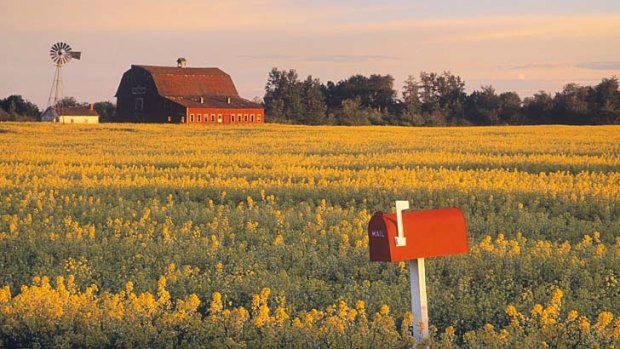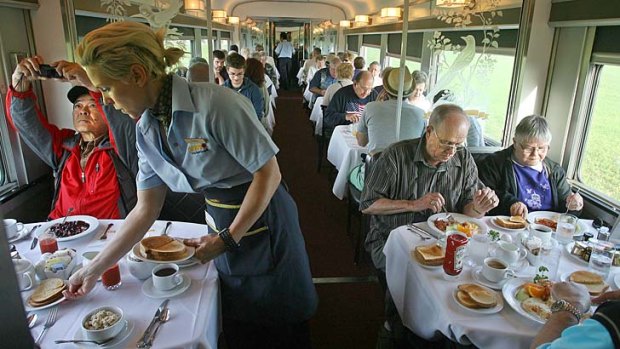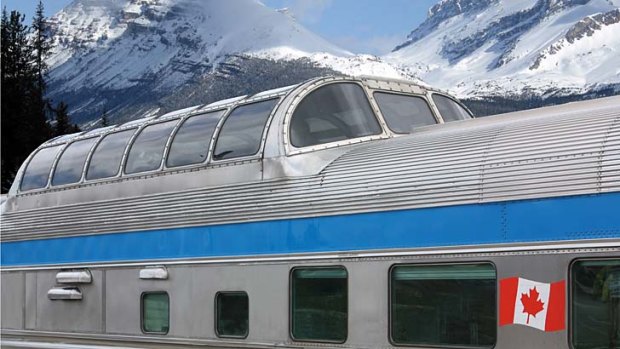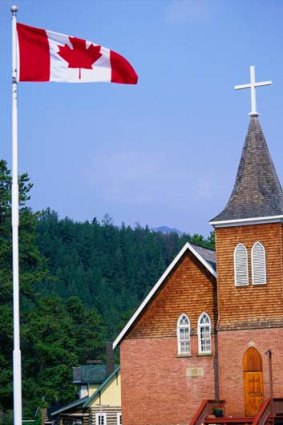
Grand relay ... rural Leduc.Credit: Getty Images
In a stop-start journey on the Canadian, Lance Richardson watches a nation and nearly 4500 kilometres roll by.
After a while, the cabin window begins to resemble a cinema screen, with the wilderness outside a film projected for an audience of one. Lying in bed and rocking gently with the motion of the train, a nudge of the toe is all it takes to roll back the shutters and begin a picture show of cottonwoods and misty mountains. It is a grey day, full of mystery. There are power lines tangled in the trees, an abandoned blue boat glimpsed fleetingly on the Thompson River. "Two coyotes!" a young voice yells in the corridor, running down the length of the carriage and slamming a door.
The Canadian is a strong contender for the most famous train journey in North America. It is certainly one of the most ambitious, yet leisurely, taking four nights to cross from Vancouver to Toronto (or vice versa), a distance of 4466 kilometres. This means it does not quite bisect Canada, relaying from the Pacific coast to Lake Ontario, but meanders over five provinces and through a list of important regional centres: Edmonton, Saskatoon, Winnipeg. It even takes in a famous national park, Jasper, slinking through the Yellowhead Pass.

Breakfast on the Canadian.Credit: Alamy
I have heard rumours about the Canadian for years - that the Rocky Mountains are breathtaking and vast; that the Saskatchewan prairies are flat and stultifying - but I have never spoken to anybody who has gone the whole way.
So here I am, in a small but comfortable sleeper that is vibrating like a soothing om. After engaging the carriage shower - something that should only be done with humour and a firm grasp on the soap - it is time to greet the day in the dining car.
Indeed, all days are greeted and farewelled in the dining car. We are less than 14 hours from Vancouver and it is already clear that this is the heart of the train: its gathering place and pacemaker, regulating time for everything aboard.

The observation car.Credit: Getty Images
The loudspeaker directs passengers to the second seating of the morning, four carriages down. When I arrive, still unsteady from the constant motion, the car is abuzz with talk of an early bear sighting. The sighting, however, was by the driver and nobody else can corroborate it.
The art deco dining car features large windows that grant patrons an unimpeded view beyond the crisp white linen and sunflowers in small vases on the tables. After taking my place, I notice a farmer slide momentarily into view, nudging his cattle through an open gate. Then he's gone, replaced by fir trees with hoary limbs and peaks with snow on their shoulders like dandruff. A thin rain shatters the surface of a pond; fog lingers in dark hollows.
Sometimes the train will brush against features in the landscape, like Pyramid Falls, where water falling around a pointed piece of rock seems to drop only metres from the carriage. Other times we draw back, the world opening out on a sublime tableau of pristine nature.

A church in Jasper.Credit: Getty Images
"These are the Rocky Mountains," the waitress tells me, nodding at the window. "Would you like some coffee, honey?"
As a mode of travel, trains are a foil to hyperactivity. We see the land in macro, dwelling on its details. It is travel for the sake and pleasure of it. As Paul Theroux notes, "Anything is possible on a train: a great meal, a binge, a visit from card players, an intrigue, a good night's sleep, and strangers' monologues framed like Russian short stories."
Over the course of my journey I will brush up against enough short stories for a long book, including an elderly lady who abandoned retirement in Halifax to drift around the continent; and a teenage boy whose mother has recently died - "I needed some space," he says in grand understatement. But the most striking story is reserved for the railroad.
Without trains, the Canada we know today would not exist. Like its effect on the US to the south, the railway helped pull the provinces into a single country. First there was Quebec and Ontario, linked by rail to Nova Scotia and New Brunswick shortly after confederation, in 1867. Then Manitoba fell into line. British Columbia, on the west coast, was the last to come to the party, mostly because it was so far away. It took the promise of a transcontinental railway to persuade it to join - a pledge the Canadian government would probably have reconsidered had it known the problems that were coming.
To begin with, nobody could decide on an appropriate route, so difficult was the terrain; then there was a bribery scandal that triggered the sacking of the the prime minister. Funding threatened to run dry; floods caused interminable delays. Chinese workers toiled in appalling conditions, sometimes dying in explosions. And the native people were less than thrilled by this new intrusion into their domains. By the time the last stake was driven into the ground at Craigellachie, British Columbia, on November 7, 1885, the Canadian Pacific Railway was the longest in the world and a debacle that even managed to incite an armed rebellion.
For many years, the Canadian followed this original route, passing through Calgary and Regina. In 1990 it switched to the more northerly line it follows today, only rumbling over Canadian Pacific tracks near Vancouver and Toronto. Nevertheless, the rich history of the railroad is a constant presence.
After breakfast we pull into Jasper, the national park's eponymous town, an important rail stop a century ago. Once there were dozens of railroaders and their families living here, with more people making a living from steam locomotives than from tourism. This legacy remains plainly visible: filled with ski-hire stores and seasonal workers, the town huddles around its station, memorably marked by a Haida totem pole named Two Brothers.
One of the wonderful things about this journey is the ability to disembark along the way, picking up the trail when the next Canadian rolls through. Passengers can, on request, stop anywhere they want between Capreol and Winnipeg for a back-country adventure.
It is worth a delay in Jasper to see the crystal vista of stars in the world's largest dark-sky preserve; a festival celebrates it each October. And while skiing dominates the region in winter, warmer months are ripe for hikes around the strange reservoir of Medicine Lake, which spontaneously drains, or climb to the top of Old Fort Point, an exposed knob of rock sticking up from the valley floor. There is nothing but the Rockies, white spruce trees and a palpable sense of what it must have felt like to be a fur trapper here in the 19th century, making a deep, westward plunge into true wilderness, before the railroad corralled Canada into being.
Even now, the wild remains stubbornly resilient, adapting to the artefacts of modern life. Take Paula Beauchamp, a charismatic Jasper guide who shows me around Maligne Canyon. "When I was younger my father used to drive us kids out to the dump, where he'd let us out to look for grizzly bears that had learned to graze there," she tells me. "He'd stay in the car. Sometimes I think my father didn't want six kids. We all survived though."
After two nights in Jasper I return to the train, and just in time for dinner. None of the faces in the dining car are familiar, but this is part of the charm: an endless parade of new encounters. From a menu that changes daily, I order a chilli-enhanced fillet of salmon, with fresh coriander and a creamy lime dressing. "Pretend there's no price tag," says the waitress, winking. There is no price tag.
If the journey from Vancouver to Jasper is one played out on a grandiose backdrop of mountains, then what comes after is humbler, though no less impressive. The passengers shift, with fewer international tourists numbered among their ranks; the further east we go, the more French mixes in with English. And the train contracts to reflect this new composition, losing a panorama car with its glass roof.
Overnight we drift past Edmonton onto prairies. I wake to a sepia world of wide grasslands broken only by the occasional red barn. It is beautiful and stark.
Given its emptiness, however, the focus turns inwards to the train's inhabitants. A musician becomes an event, trailed through the carriages by an impromptu fan club. Wandering into the recreation car, I encounter a group of people playing bingo; a woman begs me to take a card. "Prizes," she says, pointing at a pile of postcards. "Such wonderful prizes!"
"You missed the wine tasting," the attendant whispers to me.
Indeed, with two days of almost uninterrupted transit, everybody becomes a character. There is the woman who harangues other passengers with the unsinkable good cheer of Molly Brown. There are the two Americans, like the critics from The Muppets, who make pronouncements on everything, from breakfast ("I don't know if I dislike the toast or the jam more") to Canada in general ("Trees and rocks: my kind of place").
Then the prairies give way to the Canadian Shield, characterised by pine forest, bogs and lonely lakes.
It's easy to think that the world is at capacity, but Canada, like Australia, has more empty spaces than filled ones. Skipping across the country like a stone is an intoxicating experience - the closer we come to the end of the line, the less willing I am to return to the world of people.
On my last evening on the train, I dine opposite an Australian woman who once went to work on the winter slopes of Whistler and never made it back to Melbourne. She is eating a piece of chocolate cake, framed by a halo of sunset. I ask her why she's here.
"I'm travelling," she replies, shrugging her shoulders. "I just had to go somewhere, you know? I came to Canada a few years ago ... and now I'm here. I guess I don't really know where I should go when we get to Toronto in the morning."
After four nights on the Canadian I feel exactly the same way.
Lance Richardson travelled courtesy of Tourism Alberta, VIA Rail and the Canadian Tourism Commission.
FAST FACTS
Getting there
Air Canada has a fare to Vancouver from Sydney (14hr 10min, non-stop) for about $1790 low-season return, including tax. Melbourne passengers pay about the same and fly Qantas to Sydney to connect; see aircanada.com.
By train
The Canadian operates between Vancouver and Toronto, though it can be joined at any point along the way. Straight through, the full journey takes three days and 11 hours (four nights), and leaves three times a week in both directions; multicity tickets allow passengers to plan stops. Sleeper Plus class has berths, cabins and suites, with access to showers, turn-down service and the dining car. Meals are included. Prices vary according to season, accommodation and time of booking. A one-way off-peak ticket for the entire distance costs from $C940 ($920) a person. See viarail.com.ca/canadian.
In Jasper
The only year-round resort accommodation in Jasper National Park is the historic Fairmont Jasper Park Lodge, in 240 hectares of pristine forest with cabins on the edge of a turquoise lake. Rooms from $C229 a night; see fairmont.com/jasper.
Paula Beauchamp was a park interpreter who now runs a company offering walks, bird-watching and cross-country skiing. See walksntalks.com.
Fascinating Jasper and railroad history can be found at the Jasper Yellowhead Museum and Archive, walking distance from the station. See jaspermuseum.org.
This year's Jasper Dark Sky Festival is held on October 12-14, including film screenings and astronomy presentations. See jasperdarkskyfest.com.
More information
See travelalberta.com; canada.travel.
Sign up for the Traveller Deals newsletter
Get exclusive travel deals delivered straight to your inbox. Sign up now.